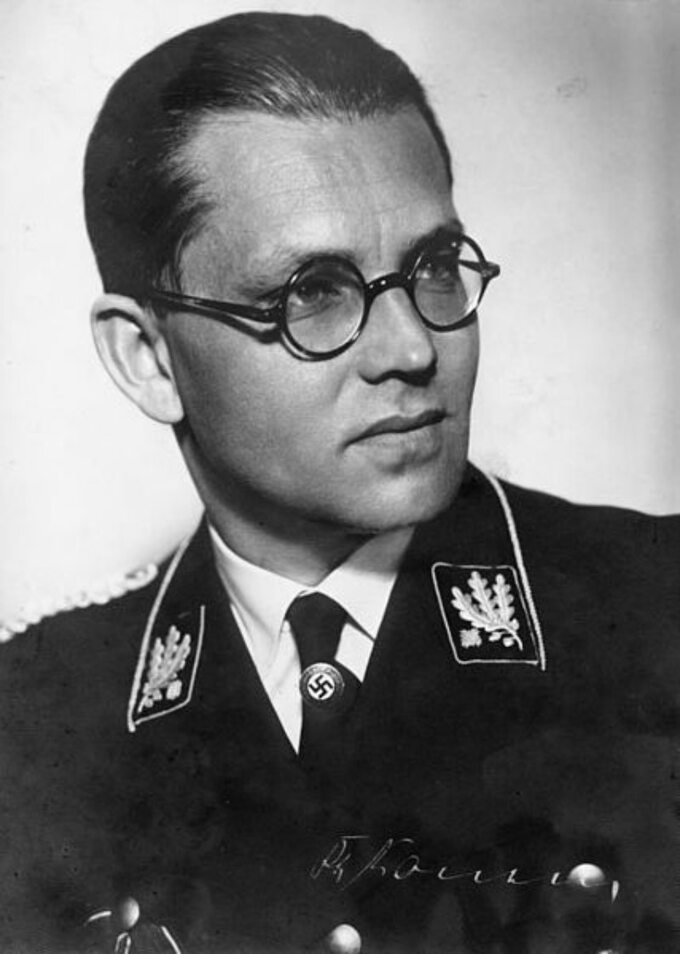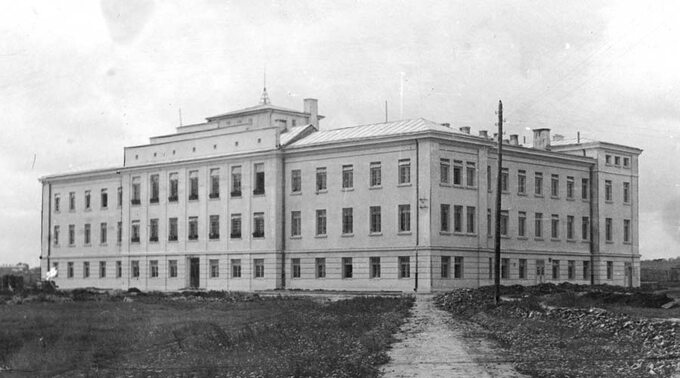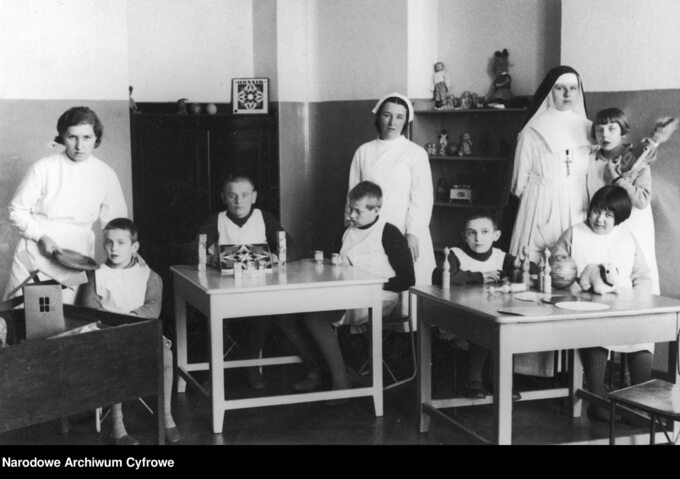On January 12, 1940, the Germans killed about 400 patients of the psychiatric hospital in Chelm. The German crime at Chelm's mental hospital is just one of many cold-blooded crimes committed by the Germans as part of Operation T4 – an operation to eliminate all humans “not worth living”. Their killing was euphemistically described as “diminishing suffering”.
Life is not worth living
The murder of Chelm patients was just one of many crimes committed by the highest echelons of German government. It should be noted here that the extermination of the sick and disabled did not take place only in the territories occupied by the Germans. The German authorities were already trying to eradicate all the sick in their own country. Germany was supposed to be a model country where there was no room for weakness and physical or mental limitations. All disabled or incurable diseases were to be killed.
In the summer of 1939, Theo Morel, Hitler's personal physician, prepared a memorial at his request, titled “Liquidation of creatures unworthy of life.” The head of the “Action T4” program was the head of Hitler's Chancellery, SS-Obergruppenführer Philipp Bühler. The final decision to implement Action T4 was made on September 20 or 21, 1939, at a meeting held at the Grand Hotel in Sopot, which still exists today.

Aktion T4 or E-Aktion (Action T4) was a program for the extermination of the sick and disabled, or “the elimination of life not worth living” (German: Vernichtung von lebensunwertem Leben). The name of the action came from the address of the office at Tiergartenstrasse 4 in Berlin, where the Reich State Labor Society for Nursing and Medical Institutions was located, that is, the institution that served as the headquarters of the action. The entire “enterprise” was headed by the Führer's Chancellery. Not only Hitler, his office and the SS were involved, but also thousands of doctors, nurses and other medical personnel. A few tried to prevent the mass extermination of vulnerable people, but many doctors obeyed the German state policy of killing the terminally ill without batting an eye.
Germans involved in Action T4, even among themselves, used euphemisms such as “end of suffering” or “mercy death” to describe the killing of people. It's sad, but it's hard not to get the impression that similar methods are still being used today by people promoting the “civilization of death”, euthanasia and abortion. Today, killing an elderly, sick person is sometimes referred to as “grace” or a sign of mercy, and killing an unborn child, especially if there is a sign that it might be born sick, is explained by mercy and unnecessary avoidance. Suffering.
T4 action
The extermination of the sick and disabled had, first of all, an ideological dimension: it was necessary to kill everyone who carried the “ballast” of a potential genetic disease, and at the same time only the “racially pure” ones should be alive. ; And secondly, the economic dimension: the destruction of the sick “relieved” the medical personnel needed during the war and also allowed to save the food needed during the conflict.
In Germany, the whole action was held semi-officially. The families of those killed in Operation T4 have been notified of their deaths due to natural causes. An uprising was feared, so relatively few knew about the real purpose of the action, mainly doctors and nurses, of whom only a few expressed opposition, mainly from Catholic circles.
In late September/early October 1939, the T4 operation moved into the occupied territories, first in Poland. In our country, the Germans had no trouble thinking about the secrecy of the operation, so the destruction of the sick and disabled was controlled by the Gestapo and the SS.

Initially, both in Germany and in the occupied territories, people died by injecting a lethal dose of barbiturates or morphine. Over time, killing by injection was considered ineffective, so other methods of mass killing were sought. The Germans then began experimenting with poisonous gases such as carbon monoxide, car exhaust, and hydrogen cyanide. For the needs of Action T4, the first stationary gas chambers were built, as well as “mobile” gas chambers, which looked like furniture carts from the outside. Mobile gas chamber was used for the first time in Ovinsky hospital. It was also used in Łódź, where in the summer of 1940 the Germans killed the patients of the “Kočanovek” hospital. Moreover, about 250 people were taken from Łódź to the Luchmierski Forest near Zgierz, where they were all shot.
The methods of killing sick people used by the Germans were also a “chance” to test the mass killing methods that were later used in concentration and extermination camps.
In Poland, the Germans did not have to hide what they did with the sick. In addition to killing in gas chambers, the most “usual” method was used, that is, people were killed by shooting. Such crimes were committed in many places in our country. One of them was the Chelm Psychiatric Hospital.
German crime in Chelm Hospital
Chelm's psychiatric hospital was located in a building built in 1912 by the occupying Russian authorities. A hospital for nervous patients was established in this building in 1932, where more than 400 patients were accommodated.
On January 6, 1940, a commission consisting of an SS officer and an SS non-commissioned officer named Białas vel Bielisch arrived from Lublin at the Chelm Hospital. Acting director Dr. Gisela Madziarska took them around the hospital. The Germans were interested in every room, both the hospital itself and the surrounding buildings and grounds. They probably already demanded that the staff leave the facility, but they did not agree to abandon the patients.
Madziarska guessed what the Germans were going to do. Doctors and nurses began to wonder how to hide patients or how to tell families to take their loved ones home. However, the Germans did not agree to inform the families and confiscated all the food in the hospital.

A few days later, on January 12, 1940, a group of SS soldiers arrived at Chalmi Hospital. The building was surrounded by soldiers and machine guns were deployed. The officer in charge ordered all medical staff and all hospital workers to assemble outside. Of these, ten nurses were selected and told to go back inside and stay with the patients. One of them was a volunteer named Jan Borzyszkowski, an alleged informer who joined the Gestapo shortly after the events at the hospital.
All staff were ordered to leave the hospital premises immediately. “Run as fast as you can and don't you dare look back,” they told him. Those who protested were beaten. As ordered, these people went forward.
Only the patients and the head of the men's ward, Dr. Telesphorus Reichel, who lived in the building, and his family, whose daughter was very ill at the time, remained in the building. The Germans allowed him to stay, but he had to cover the windows and not leave the apartment until he received permission. Thanks to Reichel, several patients were saved and the head of the hospital recommended him as “completely healthy”. These people were released.
Previously assigned nurses were instructed to remove 10 patients from the hospital building. As soon as they went outside, they were killed by machine gun fire. At first, patients meekly left the hospital, having no idea what was about to happen. However, it was short-lived as they panicked on hearing the gunshots and started to run away. Then the Germans rushed in and chased people down the corridors of the hospital. Some were killed in bed, others were thrown from windows to be shot on the ground.

At first, sick adults were killed. In the last “row” were the children who were the most difficult to catch. Most of them panicked and started looking for a hiding place. The Germans searched every room, killing children hidden in beds and wardrobes. Some were taken outside, where they were killed by a machine gun.
On March 12, 1940, the Germans killed about 400 people in the psychiatric hospital in Chelm. The next day, German executioners ordered nurses to collect the bodies and move them to a mass grave in a nearby bomb crater. The bodies were sprinkled with lime and covered with snow because the ground was very frozen. The grave was covered with sand only in the spring, during the thaw.
Just three days later, in a hospital cleaned by the same nurses appointed by the Germans, lived those who would commit crimes against the sick. The Chelm Hospital building became the headquarters of the SS.
Leszek Janacek, the author of the article “The Forgotten Tragedy of the Psychiatric Hospital”, states that after killing almost all the patients of the Chelm Hospital, the Germans who lived there killed the patients three more times: three times, their children were brought to the hospital by parents who knew nothing about the tragedy that happened there. Then the Germans had to disguise themselves as rulers and receive “patients”. When the family left, the sick were immediately killed.
The Germans also received about 350,000 marks from the hospital in Chelm. According to Dr. Janeczek: The Germans took mentally ill people away from their families (made them pay for it) and told them they were sending them to Chelm Hospital for treatment. In fact, these people were killed much faster, probably still in Germany. Some time later, families from Chelm were notified that their loved ones had died of “natural causes”.
The hospital records were completely destroyed by the Germans. After the war, only the names of 22 teenagers and 17 killed children became known. The former hospital building became the headquarters of the SS, later the Gestapo, and in 1941 a military hospital. After the war, a high school of nursing and treatment units of the hospital were established there. The mass grave is located 150 meters from the hospital. A cross and a plaque commemorate this place.
Also read:
Crime in Ochotnica Dolna. Germans gave Poles “Bloody Christmas Eve”.Also read:
Trial of doctors. Which Germans were punished for their pseudo-medical crimesAlso read:
Concentration camp for children. What nation could do such a thing?
(translate tags) action t4
